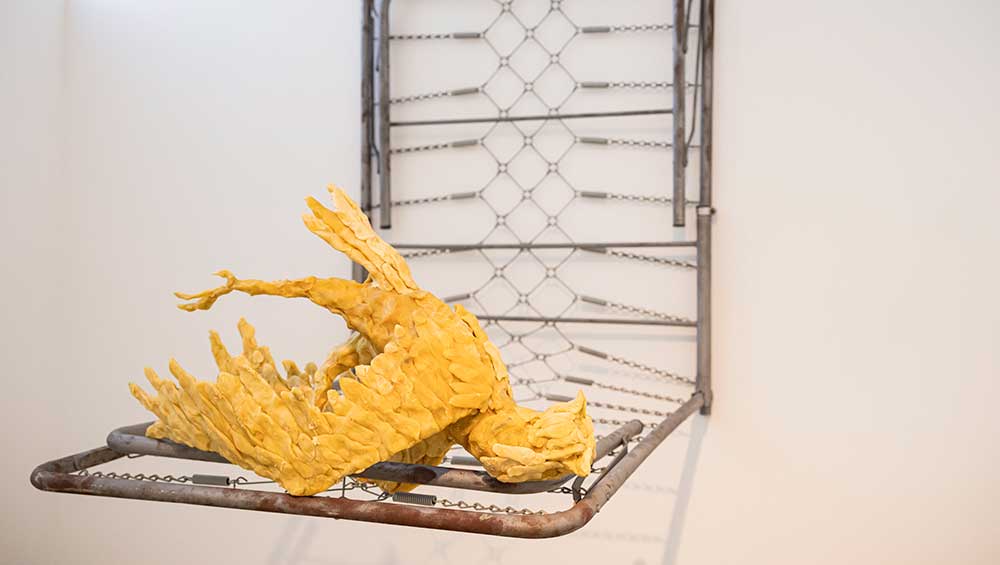
Installation view, Bekhbaatar Enkhtur: Hearsay, Fondazione Sandretto Re Rebaudengo, Turin, 31 October 2024 – 5 January 2025. Photo: Giorgio Perottino.
Fondazione Sandretto Re Rebaudengo, Turin
31 October 2024 – 5 January 2025
by TOM DENMAN
Chance, contingency and the random, often allied with the ephemeral and the fleeting – as in a shooting star, for instance – have as much to do with our experience of art as do the considered intentionality of its making and the illusion of its permanence. The day before I went to see Bekhbaatar Enkhtur’s solo exhibition at the Fondazione Sandretto Re Rebaudengo in Turin, my laptop’s screen began to malfunction and I needed to have it repaired. As a stopgap, I am using a slow, clunky old thing I had not opened for several years. When I did open it, I found myself suddenly moved by the background display, a reproduction of a painting I had long forgotten downloading. The image – serendipitously a baroque allegorisation of the passing of time – catapulted me back to the memory of seeing the real thing on the first New Year’s Eve after the pandemic, and this involuntary recollection triggered in me a deep sense of loss that resonated with the temporal theme of the work.
I was still reeling from this mediated, post-digital encounter when I saw Enkhtur’s Hearsay, an exhibition the Mongolian-born, Turin-based artist was awarded as part of the Illy Present Future Prize, which he won in 2023. It is this win, or what he sees as his good luck, that he has chosen as the show’s theme, channelling it through his signature sculptures of beeswax and aluminium. A key quality of Enkhtur’s works to date has been ephemerality, interwoven with symbolic and metaphorical allusions to the randomness of meaning. Oddly, his materials are less visually haptic than you might imagine: the beeswax is almost too alive-looking to invite touch (I feel more inclined to sniff it), the aluminium not quite matt, not quite glossy – it is as if the sculptures existed at the threshold two realities, part formed in physical space, part formed in the mind. When art is so often and all too heavy-handedly beset with meanings it never asked for, and when the structures of art – including its prizes – are artificially presented as following a linear, careerist logic, Enkhtur’s playful insinuation that none of this has to matter is refreshing.
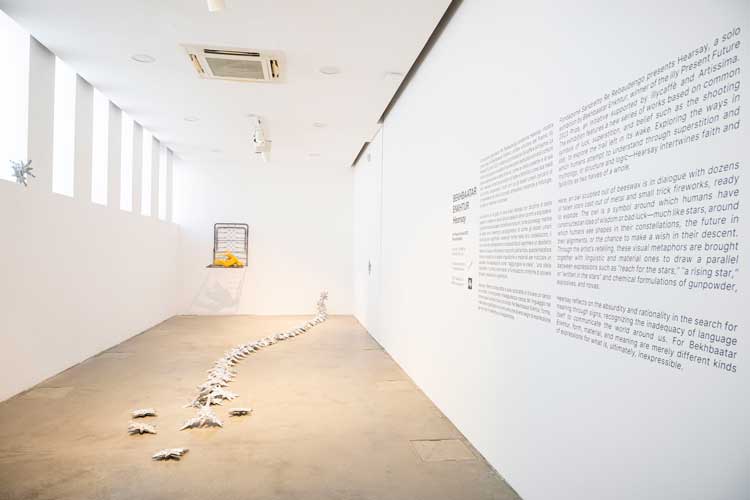
Installation view, Bekhbaatar Enkhtur: Hearsay, Fondazione Sandretto Re Rebaudengo, Turin, 31 October 2024 – 5 January 2025. Photo: Giorgio Perottino.
For his 2023 show at Matèria Gallery in Rome, he remodelled in beeswax a statue of the Buddhist sage Migjid Janraisig in Ulaanbaatar, first built in 1913 to celebrate Mongolian independence from China, then destroyed by the Soviets in 1938, and rebuilt in 1996. Though this history may be seen to reflect the resilience of Mongolia’s spiritual identity against political oppression, Enkhtur has presented an emaciated figure flat on his face, as if exhausted by his very obligation to mean something. The work hinted at an interdependence between the monument and what it stood for, implying that, in the grand scheme of things, both are as transitory as each other. In Matèria’s booth at last year’s Artissima art fair (for which he won the Illy prize), Enkhtur placed a beeswax lotus flower on the floor against a backdrop of aluminium takeaway food containers on which were engraved moments from myth and fable. The disposability of these surfaces curtailed the entrenchment of solid mythological meaning, mirroring the fleetingness imperfectly symbolised by the flower – symbolism which, too, was imperfect, with brittle beeswax recalcitrantly at odds with the supple transience of petals.
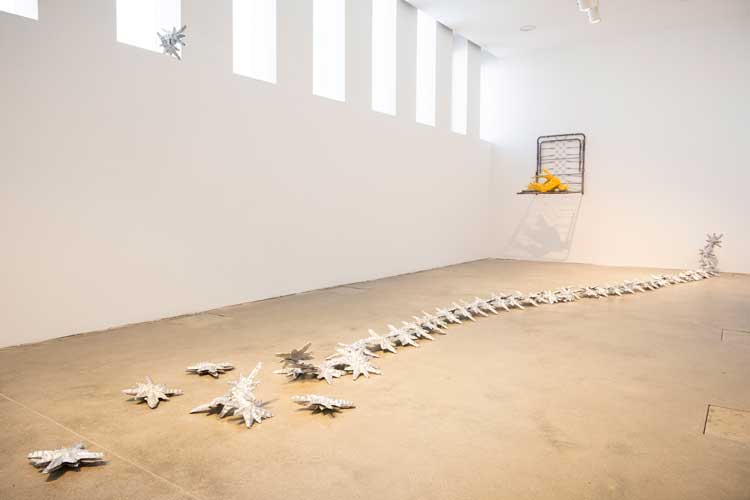
Installation view, Bekhbaatar Enkhtur: Hearsay, Fondazione Sandretto Re Rebaudengo, Turin, 31 October 2024 – 5 January 2025. Photo: Giorgio Perottino.
In his Turin show, luck, chance and happenstance are rooted in the symbol of the star – mythically looked at, in cultures worldwide, to illustrate that which is beyond empirical explanation – and the overall setup has the poised asymmetry of a constellation. As I enter the room, on the wall to my left, a small, squarish image whispers; in a scene delineated out of yellowish beeswax on white paper, which has been folded over a frame to give the artwork a sculptural presence, someone resembling the artist lies in a bathtub surrounded by dumped clothes. Understood biographically, the man’s supine pose could allude to the Enkhtur’s self-effacing view that his winning the prize was a matter of chance, and thus partly beyond his control, while his upturned gaze – idiomatically if not literally – could be directed at the heavens.
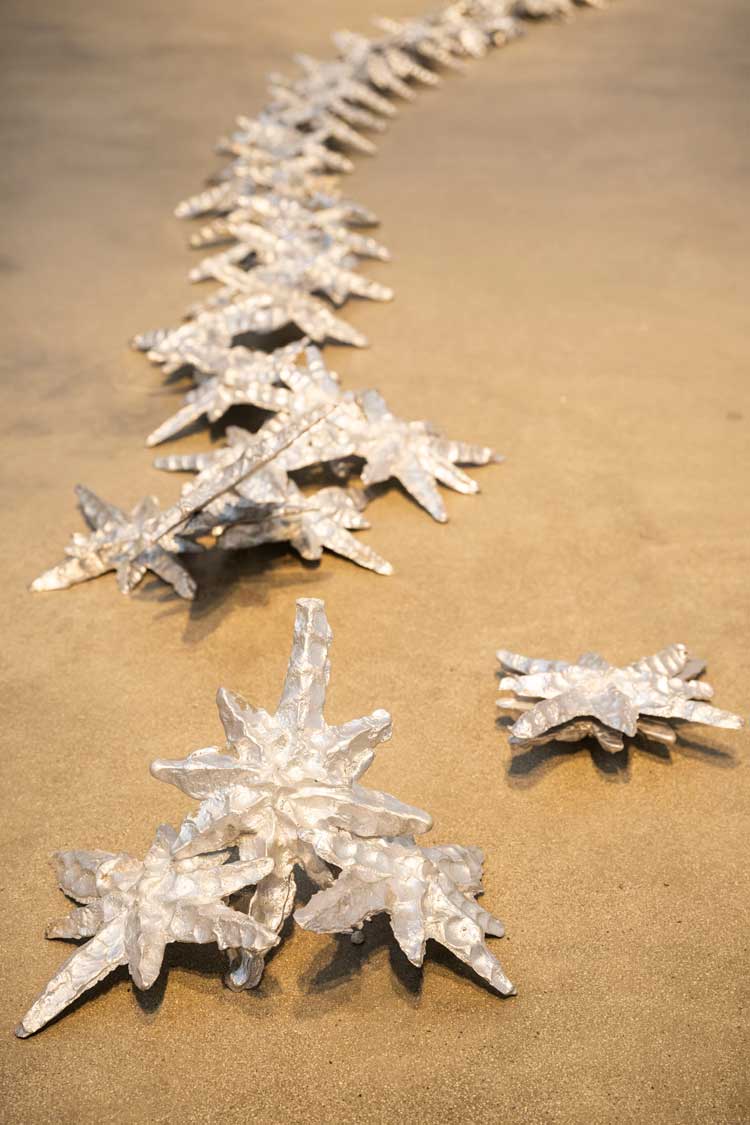
Installation view, Bekhbaatar Enkhtur: Hearsay, Fondazione Sandretto Re Rebaudengo, Turin, 31 October 2024 – 5 January 2025. Photo: Giorgio Perottino.
Running diagonally along the floor is a vertebrae-like line of aluminium stars resembling an excavated marine beast. High in one of the windows, two stars are locked in what could be a loving embrace or some kind of combat – like an eloping couple, or a pair of disgruntled so-and-sos who have decided to take a matter outside. One lone star appears to have lodged itself in another window frame, like shrapnel or a shuriken, a violent association prompted by the knowledge, imparted by the wall text, that these stars contain tiny firecrackers – in fact, when a group of students visited the show the day before the opening, one of them accidentally trod on a star causing it to pop. While the aluminium component’s explosive potential might not be much of a risk to visitors, it hints at how a minor accident – a misplaced foot – could bring an end to the artwork’s material existence, thereby mirroring the role that accident might have played in its coming into being.
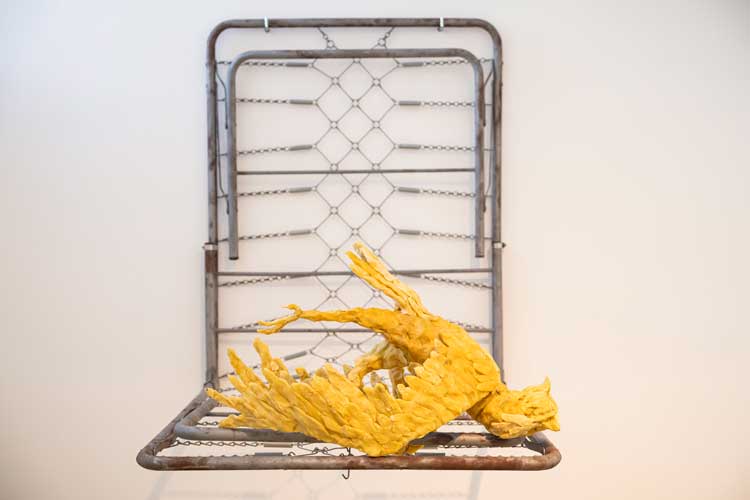
Installation view, Bekhbaatar Enkhtur: Hearsay, Fondazione Sandretto Re Rebaudengo, Turin, 31 October 2024 – 5 January 2025. Photo: Giorgio Perottino.
On the far wall is a small, metal bed, folded at a right angle with one side protruding like a shelf, on which lies a bird sculpted out of beeswax, collapsed on its front, feet in the air, cartoonishly beaten (one can visualise the twirling stars); the bird’s shadow is projected through the bed on to the wall beneath it, suggesting mirrored worlds and creating a feathery, dark abstraction that mimetically inverts humanity’s ancient tendency to project representational form on to constellations in the night sky: whereas stars shine in darkness, the shadow is darkness cast by the lights on the ceiling. The face-down bird – which the wall text tells us is an owl – inverts the bathing stargazer at the opposite end of the room. Another instance of circularity is in the use of beeswax: fragile and cumbersome as a material for making sculptures, and yet in essence very durable, making an excellent varnish for oil paintings and antique furniture. Nothing is, nothing means, any one thing.
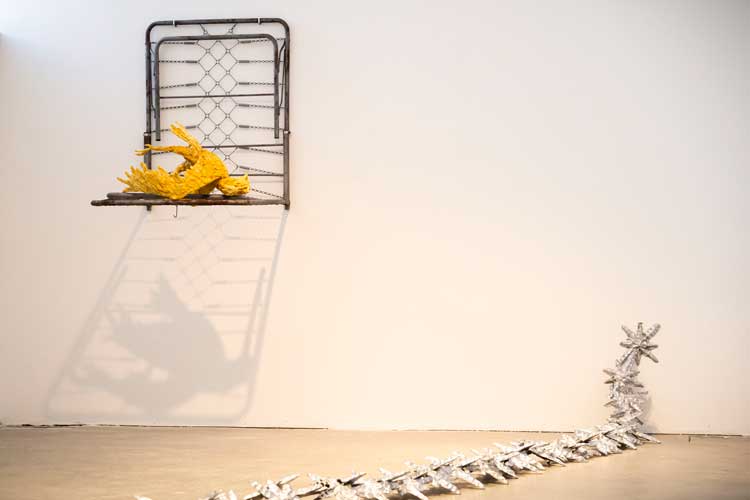
Installation view, Bekhbaatar Enkhtur: Hearsay, Fondazione Sandretto Re Rebaudengo, Turin, 31 October 2024 – 5 January 2025. Photo: Giorgio Perottino.
“I quit,” the owl could be saying, refusing to enact its archetypal role of sage or seer, in whom sight and wisdom merge to become clairvoyance – at least according to the creature’s Ancient Greek symbology, which is the frame of reference I have been culturally conditioned to bring to it. In Mongolian folklore, owls are considered not only wise but also harbingers of good fortune, as they are in Japan, while elsewhere – in parts of India and China, for instance – the owl is a bad omen and among many Native Americans it symbolises death. Enkhtur’s owl has had enough, and so it hands the reins of interpretation over to the viewer, if the viewer is that way inclined. In this show, the owl might embody Enkhtur’s self-effacement, which rhymes with the shy fragility of his sculptures, so present and yet so ephemeral, bespeaking an inevitable disappearance of what is.